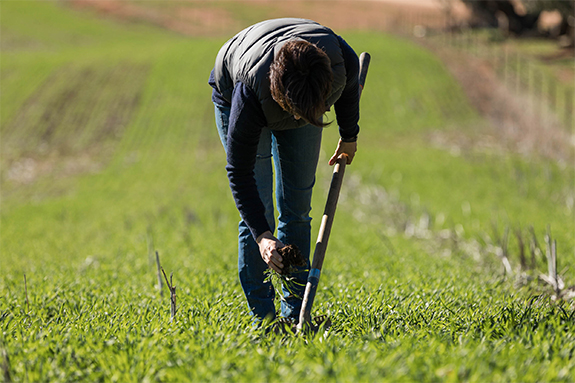Key Points
-
There are many soil indicators that could be used to measure and monitor soil performance.
-
The review found that no individual soil property or group of properties can universally indicate soil performance across all farming systems, ecosystems, geographies, seasons and markets.
-
The usefulness of any indicator, or suite of indicators, can only be truly evaluated within the context of the business operation, its management subsystems, and the impacts of management decisions.
-
Soil performance may be evaluated as the sum of soil capability and soil condition, where capability indicates potential and condition indicates actual state at the time of measurement.
-
A collection of indicators may be a more realistic measure of soil performance.
Background
Measuring, monitoring and understanding soil properties helps land owners to make land-use and nutrient planning decisions that may improve soil performance. Soil properties are measured via soil performance indicators often categorised as biological, chemical, or physical indicators.
The Challenge
Measuring and monitoring soil performance is challenging. Although there are many indicators available that measure soil health and function, due to the variability and variety of soil properties, the selection of which indicators to apply is specific to the needs of localised soils and their intended use.
The Opportunity
The Soil CRC has the opportunity to guide the development of practical management tools for farmers and those that advise them.
Our Research
- A global literature review was undertaken to ascertain key soil properties that could form the basis for soil performance indicators, and to identify the need for developing new, robust and affordable indicators. The comprehensive review was partitioned into physical, chemical and biological indicators, each led by experts in those fields.
- A workshop of all project participants was held and an online survey conducted to collect data from agricultural industry practitioners. This ensured that project outputs were a true consensus of industry and research perspectives, delivering research findings and recommendations that were pragmatic for industry, and relevant to future Soil CRC projects.
- A comprehensive review of the globally available data on soil indicators was completed and assessment of potential for real-time delivery of data to end-users.
Outcomes
The project team concluded:
- There is a genuine need for soil indicators for many purposes including, soil performance and condition for farmers, natural resource management, catchment management, environmental protection, real estate, banking and finance, product marketing and branding.
- Indicators must be fit for purpose in the context of when and where they are measured. They must show how indicator values relate to a baseline, and the upper and lower boundaries of the measure for that purpose.
- Soil performance may be evaluated as the sum of soil capability and soil condition, where capability indicates potential and the condition indicates actual state. Since the indicator values vary in time and space, and in relation to each other, a collection of indicators may be a more realistic measure of soil performance.
- It is likely that more sophisticated suites of soil performance indicators will emerge over time that will be rapidly and repeatedly measured through the use of sensors, providing maps that allow both proactive and reactive management to improve soil performance.
- Soil data federation technology, standards and procedures need to be created and established to enable combination and integration of data from disparate sources, so that a common data model can be created and applied.
Next Steps
Since an overarching aim of the Soil CRC is to make Australian farmers more profitable and better stewards of their soils, capturing farmers’ data and knowledge of soil performance and condition will help in deriving a suite of useful indicators as a measure of agricultural profitability. There is also an opportunity for new discoveries to occur that will benefit end users.
From the review and analysis undertaken through this project, seven future research projects have been recommended to fill the gaps relating to soil performance indicators and meet Soil CRC milestones.


Project Team
Peter Dahlhaus, Megan Wong, Andrew MacLeod (Federation University)
Mark Imhof, Doug Crawford, Pauline Mele (Department of Economic Development, Jobs, Transport and Resources)
Bryan Stevenson, Gwen Grelet (Manaaki Whenua Landcare Research)
Naomi Wells (Southern Cross University)
John Bennett (University of Southern Queensland)
In addition, another 26 Soil CRC members from research and industry contributed to this project.
Project Reports/Publications
Dahlhaus P.G., Bennett J.McL., Corbett J., Crawford D., Grelet G., Imhof M., MacLeod A., Mele P.M., Stevenson B., Wells N. and Wong M. (2018) A review of indicators of soil health and function: farmers’ needs and data management. Final Project Report, Soil CRC.
Four short videos have been produced to present the findings of this research:
- What are soil indicators?
- Are your soil indicators fit for purpose?
- Is a suite of soil indicators a better measure of soil performance?
- The Soil CRC journey to find soil health, soil function and soil performance indicators.
These videos are available on our website.
Fact Sheet Author
Peter Dahlhaus (Federation University)
Posted Mar 21, 2021

